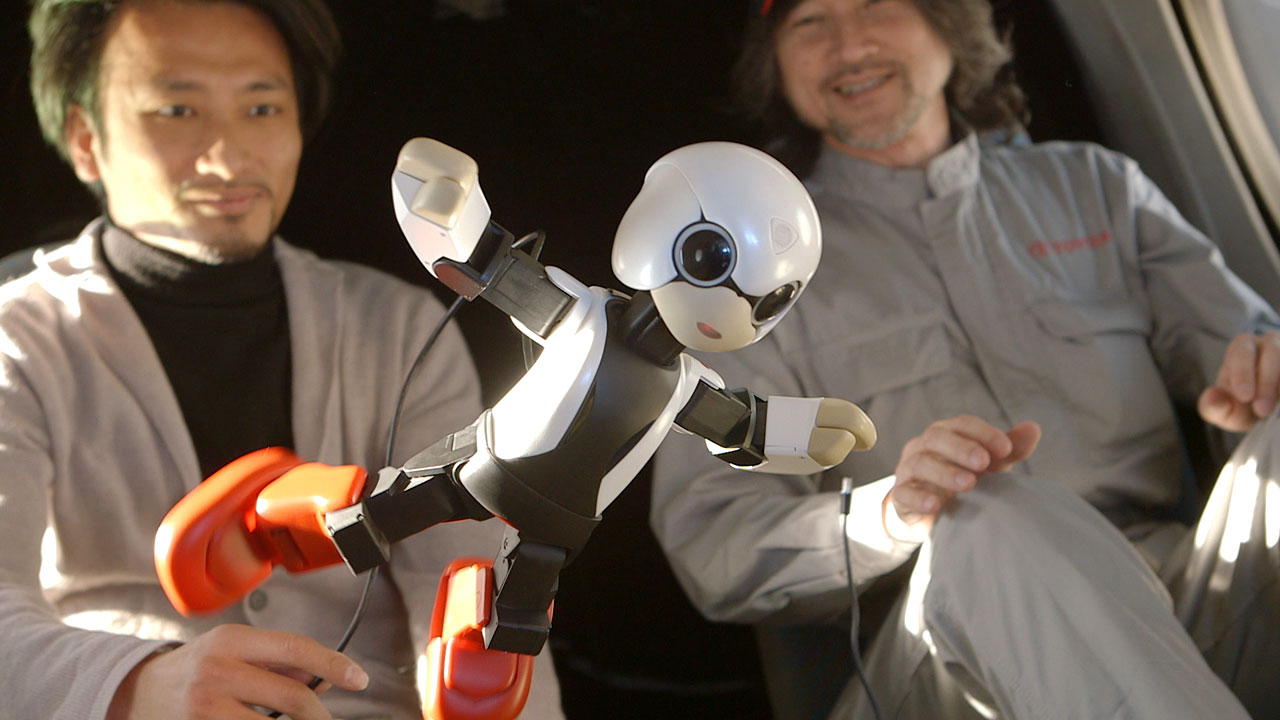What will it take for robots to become as common in our homes and daily lives as smartphones, TVs and computers? Ask roboticist Tomotaka Takahashi. The famous Tokyo professor aims to be “the Steve Jobs of robotics”, by moving away from technical specs and emphasising design, as well as pure bot charisma.
How? In a nutshell, by making robots cute, tiny and communicative. And internet-enabled; picture a smartphone but with a face and limbs. To accomplish this, Takahashi has an ace up his sleeve: He’s getting ready to debut a pocket-sized smart robot with all the features of Siri, designed to look, act and feel like it’s your close friend.
“Unfortunately, most professionals in robotics do not have this point of view,” Takahashi says. “My strategy is, buy humanoid-shaped robot smartphones with monthly payments at a phone store, instead of buying expensive robots in a robot shop and learning how to fit in our lives.”
Takahashi, a renowned roboticist and associate professor at University of Tokyo, believes friendly bots that can coexist peacefully with humans are the key to making personal robots the next consumer electronics revolution. That’s a larger, longstanding trend in the Japanese robotics industry: Japan is the birthplace of Pepper, the talking android that reads human emotions; PaPeRo, the cutesy personal assistant introduced way back in 2001; and the Aibo robotic dogs that users became so emotionally attached to they held funerals for the mechanical pets.
“It should be fun,” Takahashi says. “Not like Terminator.”
Terminator Ruined Us
But in the US, one major obstacle blocking mass adoption of personal robots is the pervasive cultural image killer machines bent on taking over the human race (or at the least, stealing our jobs). We have pop culture and decades of military robotics funding to thank for that.
“As the entertainment industry in Japan was creating robots as ultra cool toys for boys and girls, [America’s] was creating robots that would take over the world and kill us all,” says roboticist Richard Alan Peters, a professor at Vanderbilt University.
In Japan, the public perception surrounding robots is a bit different. The comfort level with robots in is higher than in the US. From Honda to Sony to Fujitsu, big Japanese companies payroll projects that produce humanoid robotic workers, robotic news anchors, even robotic animals. And consumer preferences fuel different kinds of robotics research and competitive business — two vital ingredients that will get more robots on more shelves of more electronics stores.
Up until around 2008, most of the funding for US robotics came from the Department of Defense, and many robots were chiefly made for military use. Japan, however, has been selling robots to consumers for decades.
Earlier this year, the most sophisticated of all, Pepper, went on sale and proceeded to sell out its first batch of 1000 in under a minute. Robots are quickly becoming co-inhabitants with humans: There are cuddly robo-polar bears are caring for seniors, while Tokyo’s Haneda Airport is set to add robots to help human staff this month, and Japanese shops are looking to hire robot sales associates.
But while Japan churns out Peppers and Aibos, American robots tend to be scarier, larger, often relegated to factories. MIT Technology Review published a great piece back in 2010 entitled, “Why Japanese Love Robots (and Americans Fear Them).” In it, Christopher Mims writes:
The affection of a certain island nation for all things robotic — from 30m tall warfighting mecha to infantile therapy robots — is well known. It contrasts sharply with the equally entrenched Western fear of automatons, beginning with the very invention of the term “robot,” which was coined in a Czech play that debuted in 1921 in which, naturally, the robots eventually rise up and kill their human masters.
“Big, powerful robots, like Big Dog, are done better in the US,” Takahashi says. “We are good at developing precise, small, communication robots with character.”
Peters suggests the duality springs from culture differences: Japan is a monocultural, cohesive country prone to a team mindset; the US values individualism, independence and upward mobility. “[Japan] develops machines for their culture, to work with them,” Peters says. “America develops machines that will do the work for them.”
Your Next Phone Is a Robot

Takahashi’s army of 13 inch-tall Robi robots dance at a cafe in Tokyo’s Ginza district in January. The Robis recognise more than 200 Japanese phrases, walk, kick balls and dance. Credit: AP
Now, robots may be at a turning point. Takahashi’s about to drop what he hopes to be robotics’ killer app, and he hopes his latest robot will trigger big shifts among consumers.

Takahashi has already designed over 40 different types of small, human-shaped robots, built out of his Kyoto-based studio, Robo Garage. They’re cute; they talk, run, race and dance. He bases his designs roughly off Astroboy, the pint-sized superhero of ’60s Japanese manga. He believes that makes it easier for human users to want to interact with the product.
Picture: Anime, manga icon Astroboy via Wikia
Takahashi’s smart machines have been awarded multiple Guinness World Records, including the longest distance covered by a battery-operated remote-controlled model car, the first companion robot in space, and the highest altitude for a robot to have a conversation.
His vision for the future is even more ambitious. Let your imagination run wild, here. How about a 30cm tall companion that sweeps the floor, relays the weather forecast, acts like an alarm clock, plays Spotify, distracts the kids during cocktail parties and is a home security system, all in one? And it knows when you’re sad and tells jokes to cheer you up.
Specifically, Takahashi’s upcoming robot aims to be a functioning humanoid smartphone that could replace your Galaxy. But it will be a lot more than an automated secretary. He wants it to be a mechanical friend who slurps up information that helps you in everything from purchasing decisions to befriending coworkers.
“The new robot is a phone, sold as a phone from a phone company. It is a little bigger than the iPhone 6 Plus,” says Takahashi. “We would like it to be a major hardware platform, just like Nintendo or iPhone.”
It’s still unnamed, and Takahashi declined to give much information about the product. Huffington Post has a few more details:
Instead of sharing a stunning photo on Instagram or your thoughts on an interesting movie on Twitter, you could talk about it with your robot in the moment. Not only that, but your robot would remember the shared experience, years later. Your relationship with your robot would be strengthened over time by the memories that you share together, Takahashi said.
You could use your pocket robot for lots of other things too. If you tell your robot you’re hungry, it could remind you when you last ate, or tell you that around the corner, there’s a sushi place (which your robot would know is your favourite type of food). Your robot could also help you better connect with humans, Takahashi said. For example, if you’re about to meet a new co-worker, your robot could — after scanning the Internet or that person’s robot — tell you that the new co-worker shares a hobby with you.
And there’s great commercial potential. The more information a device collects, the more lucrative it is. Your shopping recommendations on Amazon would be spot on, Takahashi said.
So, Takahashi envisions a Swiss Army Knife robot that also wants to be your pal. If that sounds unlikely, I’ll remind you that small robots are starting to appear more in expos, stores and eventually residences.
Often inspired by the smart home movement, these little ‘bots are often built to only do one specific thing, like sprinkle your lawn or clean your grill. At CES this year, those kinds of robots were presented to expo-goers. No doubt, there’s a growing market of companies pushing to get small, convenient robots to buyers. It also shows that not all American robots are militaristic or assembly line mainstays. (Likewise, not all Japanese robots are chatty and adorable, and they range from heavy warehouse workers to disconcertingly realistic near-humans.)

Takahashi poses with his tiny, bike-riding, swimming and running robots at a press conference in 2011. Credit: Getty

Takahashi (left) with Kirobo, a robot he designed that was sent to the ISS in 2013, becoming the first talking robot in space. Robots like Kirobo can help us study how humans behave when they’re isolated for a long time. Picture: RoboGarage
When Will Best Buy Start Selling Robots?
Meanwhile, what will it take to make Takahashi’s vision a reality? Well, the US and Japan are two of the world’s leading robot makers, by far. (We’re even going to see an America-versus-Japan giant robot duel, supposedly.) So the key to making robots irresistible to American consumers, or Westerners as a whole, may lie in combining the two countries’ robot-making philosophies.
“America’s AI research has been consistently at the leading edge,” Peters says. “The Japanese seem to understand how robots should get along with people, be cooperative, be nice to be around.”
Achieve a certain level of consumer comfort, while still providing smart products that successfully solve a problem or provide a service, is what will take to get robots to join the great electronic devices of all time: the iPhone, the Kindle, the Game Boy, the TV, the light bulb.
Marketing can go a long way. Preconceived notions of what robots are supposed to be could prevent robots from becoming as common as smartphones in the US market, says Stephen Baker, vice president of industry analytics of consumer electronics at NPD. “Calling them ‘robots’ would be very difficult [when marketing them],” Baker says. “People would be thinking of Robby the Robot from Forbidden Planet, or the robot from Lost in Space.”
Public perception isn’t the only hurdle. Peters says that while he thinks Takahashi’s on the right track, he’s sceptical how realistic it is to think that robots will fill American homes the way laptops and DVRs and video game consoles do.
“Robots will most likely, in my humble opinion, never be as ubiquitous as smartphones,” Peters says. “As frustrating as dealing with computers has been, at least they don’t physically interact with our environments. Personal robots, while doing many good things for us, will bring us a whole new level of frustration. When they screw up they will physically break things … People will, initially at least, think the robots are smarter than they actually are and will become frustrated with a robot’s failure to understand what they are being told to do.”

Many Japanese robots are cute and humanoid, like Pepper, the face-and-emotion-sensing helper bot designed by Japanese telecom giant SoftBank. Picture: AP
And of course, there’s the money. To make that jump from early adopters to a general audience, from niche to mainstream, robots need to be sold at an accessible price point if they are to become must-haves. Pepper, for example, is that emotion-reading robot designed to share offices and homes with humans, converse with them and brighten their moods. It also costs $US2000, which is way too much when you consider the more accessible prices points of the most popular consumer electronics, like $US200 for an iPhone.
They need to solve a unique problem, they need to be affordably priced, and they need lots of marketing money behind them. Baker points to consumer electronics that haven’t done this well and ended up falling by the wayside, like the digital picture frame fad, or expensive 3D TVs that require glasses to watch.
But he also points to an emerging technology that’s finding more mainstream success these days: drones. Drones solved a unique problem — providing unprecedented, unmanned views and RC access to the skies. But at first, they cost thousands and thousands of dollars, they were incredibly niche, and only a handful of companies were making them. Now, you buy them on eBay.
Someday, maybe robots can find the same success: Might you be buying family members miniature talking robots on Black Thursdays in the future? It could only be a matter of time before robots join the fold. And when they do, it will be hard to remember life without them.
Illustration: Sam Woolley
